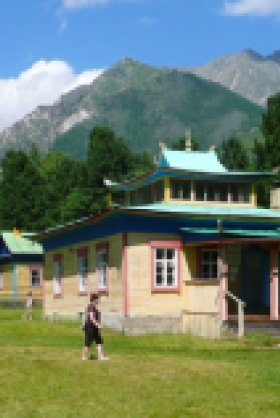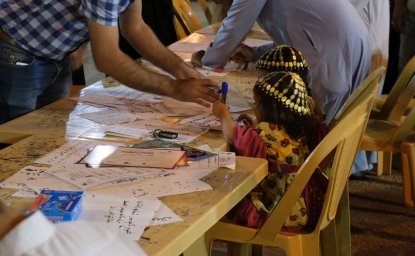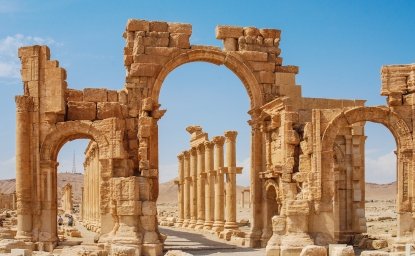“Buddhism in Post-Soviet Russia: The Geographic Contexts of Revival”


In continuation of our alumni interview series, we talked with former Title VIII-supported Research Scholar Edward (Ted) Holland to hear his reflections on his fellowship. Dr. Holland is currently a postdoctoral fellow at Miami University, Havighurst Center. See the discussion below on issues concerning religion and identity in some of Russia’s non-ethnic Russian republics today.
Malinkin: For your dissertation you conducted surveys looking at the religiosity of two republics of Russia - Buryatia and Kalmykia – what did you find that you did not expect?
Holland: I think a lot of the work that's out there makes assumptions based on classic models of religious practice and religious belief. There are certain demographic categories - typically older people and women - where there's the expectation that religious practice and belief will be higher, but when I was looking at the data what was interesting is that a lot of those patterns don't hold for the minority groups in Kalmykia and Buryatia. It might be a question of different religious traditions in Russia, and it might be a question of "rediscovering" religion after the Soviet period. That was one of the interesting findings and something I've tried to work through in the dissertation that I've been revising for publication. It's been nice to have that comparison between the Russians and the Buryats. What role is religion actually playing for the Buryats in comparison to the Russians, albeit in the same regional context, the same republic —what are some of the differences we can tease out?
One of the observations from your surveys was that ethnic Buryats in Buryatia demonstrated stronger religious belief and affiliation than ethnic Russians in Buryatia – did you get a sense there were similar things going on in Kalmykia?
I can’t say conclusively, because I only surveyed ethnic Kalmyks in Kalmykia. In Kalmykia and Buryatia, men and women among the Buddhists are pretty similar – they report similar percentages of attendance and religiosity. Kalmyks and Buryats don’t have the age disparity or the male/female disparity that is found in the world values data, where women and the elderly generally identify as more religious, as attending church more often.
Looking at the latest Russian census statistics, Buryatia was 66% ethnic Russian and 30% ethnic Buryat and Kalmykia was more or less the reverse — about 57% ethnic Kalmyk and 30% ethnic Russian — do you see that affecting things in any way?
I'm not sure exactly how that would affect things. I think that's an interesting point, but do people who practice and consider themselves to be Buddhist think about their demographic position within their republic? I'm not sure if they do, and I don't think that the survey could really tell me one way or the other. There are differences between Buryatia and Kalmykia though. In Buryatia, for example, the religious leadership among the Buddhists definitely takes a more “Pro-Russian” and pro-Russian government position. I would say that they toe the line in Buryatia more so than in Kalmykia, perhaps, and that might be a product of the demographic balance, but it's also a product of the personalities of the religious leaders in Buryatia and Kalmykia respectively. A recent article I've been working on gives a general overview of what Buddhism is in Russia and I make the argument that in Buryatia the religious leadership promotes an idea of Buryat Buddhism whereas the Kalmyk leadership wants to integrate Buddhists to international circles and frameworks.
From your discussions with respondents in both republics, what would you say was the most prominent identification with religiosity? This is a very individual thing, but if you were to name one marker that people noted more often than others – i.e. attending services, praying, cultural identification, etc. - how did most people define their type of religious belief?
I think it's mainly a cultural identification. For Kalmykia, for example, I group it together with language. The Kalmyk language has been eroded – they were one of the nationalities deported and resettled in Siberia during World War II — and so the role of religion and language were undermined by the Soviet treatment of the group. But in the late 80’s, religion became an important cultural signifier for the group that was the basis for not necessarily secessionist nationalism, but a national identity that served to unify and strengthen the community at the republic level. Certainly, like you said, it varies so much by individual, and surveys try to find the patterns. I would say that cultural identity is the dominant pattern, but of course there are going to be individuals who have really taken up Buddhism as an important part of their everyday lives.
Would you say the deportations unified people in Buryatia or was it something else?
There weren’t deportations in Buryatia like in Kalmykia. In Buryatia, I think the Dalai Lama's visit in 1991 was really important — that was the 250th anniversary of the imperial decree that recognized Buddhism as an accepted religion in the Russian Empire. So, at the same time as all the political events, the Dalai Lama came to celebrate this anniversary. It was July, so the coup hadn’t happened, but things were changing for sure. The Dalai Lama had been to Buryatia a couple of times previously, but that was the first officially sanctioned visit and a galvanizing moment. There's not the same feeling of persecution as there might be in Kalmykia, but it’s difficult to generalize.
Have there been any changes to the 1997 law on religious freedom or proposals to amend it?
There have been, but the 1997 law still stands and hasn't been as restrictive as people worried it would be. The implementation has just been very inconsistent and not as stringent as people expected. Some of the developments in the law on extremism have been applied to religious groups or religious minorities because they are not “traditional religions” that were identified by their historical presence in the preamble of the 1997 law. But the preamble doesn't really have any legal bearing. They’re recognized de facto, not de jure. The recent developments - the law on extremism and some of the court cases against Jehovah's Witnesses and the Salvation Army – are still in flux.
Do the republics that you study have their own autonomous laws on religion?
There are local laws on religion, and many of them served as the model for the 1997 law. Particularly in Western Russia there were laws introduced between ’93 and ’97 that required religious organizations or groups to register in order to be formally recognized. Those laws then served as the template for the 1997 law. In Buryatia, there’s been a movement towards greater consonance between the leading Buddhist organization and the republic’s government. There were some points of disagreement and divergence in the late 1990s, but more and more they seem to be getting along. There is also a council composed of Russian Orthodox and Buddhist leaders who work together on religious issues in the republic.
You have done work on religious and national identity in other regions of Russia – in particular in the republic of Dagestan – can you talk about any substantial differences you saw between the role of religion in Dagestan vs. its role in Kalmykia and Buryatia?
In Dagestan, the local politics of religion really exacerbates some of the socio-economic tensions, and it often leads to violence within Islam. Those individuals in Dagestan who are, so to say, endorsed by the Russian state often have an ambiguous relationship with the Sufi brotherhoods, and then there are more fundamentalist Muslims as well so you get a breakdown into groups. There are not the same kinds of divisions in Kalmykia, for example.
It's more uniform?
Yes, or, if there are disagreements in Kalmykia then they are mediated and talked over by religious and regional authorities. In general, when we talk about Dagestan, a lot of the violence doesn't stem from questions of national identity or religion. It's rooted in corruption and a lack of economic opportunity.
You noted that on a national level, Buryats are widely considered to be one of the more “quiescent” minority groups in Russia today – based on your research does it seem they will continue to be viewed as such or are there any murmurs of their desiring more political autonomy?
Things could get interesting if there was an external shock to the Russian state, but I don't think it's coming from a place like Buryatia. There were some fears, particularly in the early ‘90s, that there would be a movement to reunite all Buryat territories, so the exclaves where Buryats were living outside of the republic of Buryatia were merged into surrounding Russian regions. This was initiated by Putin’s administration, later in his first stint in office. By now, the ethnic Buryat nationalists are certainly a fringe group, but you still see talk of ethno-territorial claims every so often, on internet forums. They’re generally pretty weak, but again, if there's an external shock to the Russian state they could start to mobilize.
Authors

Kennan Institute

Independent scholar

Kennan Institute
The Kennan Institute is the premier US center for advanced research on Eurasia and the oldest and largest regional program at the Woodrow Wilson International Center for Scholars. The Kennan Institute is committed to improving American understanding of Russia, Ukraine, Central Asia, the South Caucasus, and the surrounding region through research and exchange. Read more

Explore More
Browse Insights & Analysis
Talking to the Dead to Heal the Living

Russia’s Indigenous Communities and the War in Ukraine

